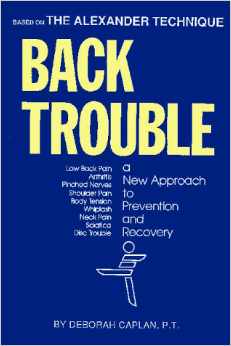by Brooke Lieb and Jessica Santascoy
Many students benefit by reading books about the Alexander Technique, because it helps elucidate concepts and ideas when taking Alexander lessons. Brooke Lieb, the Director of the American Center for the Alexander Technique and a teacher with over 20 years of experience tells us what she recommends for students, and how she uses it in her teaching, and shares F. M.’s 5 step process that you can use on your own or with a teacher.
SANTASCOY
What do you recommend new students read?
LIEB
In recent years, I have been asking my students to read the chapter “Evolution of a Technique” from The Use of the Self by F. M. Alexander, who originated the Alexander Technique. I give it to them sometime during their early lessons, depending on when I think they have had a clear enough practical experience in lessons to relate to the concepts and F. M.'s self-experimentation.
SANTASCOY
Why do you recommend this chapter to new students?
LIEB
I find this chapter particularly helpful in illuminating the idea that the student is actively engaged in the process, applying her or his thinking to influence what happens during the practical work in the lesson. There is a great deal of intellectual participation involved in learning, which can sometimes escape students when they first start to study, because of the tactile aspect of hands-on work.
Hands-on instruction is unique to Alexander. The intent and degree to which touch is used in the hands-on cuing in yoga, exercise, dance or movement instruction, or sport instruction, is completely different to Alexander. Also, hands are used so much less in those forms of learning.
I also recommend this chapter because it tells Alexander’s story, in his own words, and takes the reader on the journey of why and how F. M. made his discoveries, some of the pitfalls he had to overcome, and a simple 5 step process to explore.
I would encourage any student to seek the assistance of a teacher to demonstrate the process, but in conjunction with lessons, I have found that this piece stimulates many questions and interest in the work in my students. I find their questions, and their confusion has contributed to how I have refined and simplified how I illustrate these concepts through activities, the explanations and the analogies I use.
SANTASCOY
What kinds of responses have you gotten from students who have read the chapter?
LIEB
I recently sent this to a new student, after her fourth or fifth lesson, and she came in the next week with great interest in the ideas and concepts in the chapter, and also some extreme confusion about the 5 step process. Once I understood her confusion, I was able to explain the practical process, and how we were using this process in the lessons. She was confused by the fact that he talked about speaking a sentence, so I explained he was probably referring to a line of text, and that being an actor, he would be deeply invested in being “right” and successful when speaking text. Her question gave me an opening to talk about endgaining - the tendency to keep our mind and actions focused on an end result whilst losing sight of, and at the expense of, how the result is achieved.
I also refer to the fact that after Alexander saw what he didn’t feel in the mirror - that he was pulling his head back and down, he then assumed since he had now seen it once, he could rely on his feelings and was no longer pulling his head back and down. He returned to the mirror after a period of time, and realized that he was still pulling his head back and down, and acknowledged his faulty thinking: if he couldn’t feel it in the first place, why had he thought that in one moment of recognition, he had repaired a lifetime of not feeling it and could suddenly trust his feelings? This illustrates the force of habit, and that we’re not often doing what we think we’re doing. I find this revelation in F. M.'s story helps students begin to question how much they do or should rely on how things feel.
Some students begin to relate the practical work to ideas they remember from the chapter on their own, even if I have never articulated how the activity we are exploring relates to the concepts.
SANTASCOY
Do you refer to this material in lessons or relate your practical teaching to this material?
LIEB
Most definitely. I often reflect after the experiential part of a lesson, that what we were emphasizing was inhibition, direction, awareness, or the unreliability of how we interpret our kinesthetic sense. Having read this chapter, I find the student is more inclined to make connections to what we are doing in the activities we explore in the lesson to the practical application of the concepts they have read about. It is where the idea becomes a concrete, lived experience.
I often use the 5 step process in early lessons to teach a student how to receive my hands-on work, and to recognize the difference between allowing me to guide her or his movement, and how the student can initiate movement on her or his own. Students are able to understand the idea of doing less in upright work, and thinking more actively and participating more in table work after reading this chapter in The Use of the Self.
The 5 Step Process Applied to Public Speaking
Let’s imagine that you are going to give a presentation next week. You’d like to appear poised, elegant, and connect with the audience.
Think of a sentence that you might begin the presentation with, such as “My name is…”
1. Pause before you speak the sentence. Don't say it yet.
2. Instead, say the Alexander Directions to yourself: I free my neck to allow my head to balance delicately at the top of the spine, to allow the torso to lengthen and widen.
3. Continue to say these directions until you are fully engaged in the intent and purpose of the directions, and more committed to this new state in your system than achieving the result of speaking.
4. Then say to yourself, “I might say my first sentence, I might not.” The point is to recognize how the thought of giving a presentation may tighten your neck (and the rest of your body), and the first sentence may act as a stimulus (a trigger), that starts the tightening. But, just the thought of giving a presentation might make you tighten, so if you tell yourself you might or might not start, you are gently persuading yourself to not go into habitual tension.
5. Decide:
a. not to say the sentence and continue to direct b. to do something completely different, like “lift your hand instead of speaking the sentence” and continue saying the directions c. to say the sentence and keep saying the directions
Practicing these 5 steps will help you notice your habits, and decide to replace them with the new, efficient habit which is more easeful. When you’re easeful, audiences connect with you more because they sense that you are enjoying yourself. (These directions and the 5 steps have been modified by Brooke Lieb and Jessica Santascoy. The 5 steps as written by F. M. Alexander are on pages 45-46 in The Use of the Self.)
What other habits can you work with using this 5 step process?














